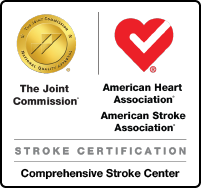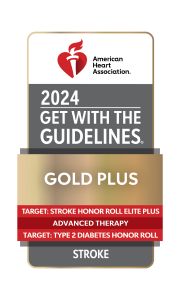Hemorrhagic Stroke
Hemorrhagic stroke is a sudden rupture in a blood vessel in the brain that bleeds into the surrounding tissue. This damages brains cells two ways:
- It stops normal blood flow in the brain, preventing cells from getting blood and oxygen.
- The leaking blood increases pressure in the brain, compressing the tissue and cells.
There are two types of hemorrhagic stroke:
Intracerebral Hemorrhage
Bleeding occurs within the brain quickly, without warning signs. It can be severe enough to cause coma or death. Intracerebral hemorrhage usually results from high blood pressure.
Subarachnoid Hemorrhage
Bleeding occurs between the brain and the membrane covering the brain (meninges) in the space between the brain and skull. The cause may be an aneurysm (a bulge or weak spot in the vessel) or a tangle of blood vessels (arteriovenous malformation) that can restrict or stop blood flow.
Hemorrhagic Stroke Symptoms
As in ischemic stroke, hemorrhagic stroke symptoms happen suddenly. The acronym 'BE FAST' can help you remember the signs of a stroke:
- Balance – Ask if the person feels dizzy or has trouble standing.
- Eyes – Ask if the person has blurred or double vision.
- Face – Ask the person to smile and see if one side of the face droops.
- Arms – Ask the person to raise both arms and see if one arm drifts downward.
- Speech – Ask the person to repeat a simple phrase like, "The sky is blue," and note whether it's correct or speech is confused, slurred or garbled.
- Time – Call 911 immediately if the person has any or several of these symptoms. Time lost is brain lost.
Call 911 immediately if you or anyone around you has one or more of these symptoms.
Hemorrhagic Stroke Diagnosis
Diagnosing the type and location of the stroke as soon as possible is critical to ensure the best treatment and outcome. University of Maryland's stroke specialists use advanced imaging such as CT (computed tomography) scan or MRI (magnetic resonance imaging) to diagnose hemorrhagic stroke.
Hemorrhagic Stroke Treatment
Treatment depends on whether the stroke is within the brain (intracerebral) or on the surface between the brain and skull (subarachnoid). The goal is to stop the bleeding, repair the cause, relieve symptoms and prevent complications like permanent brain damage. Treatment may be a combination of surgery and medication.
Surgical treatment depends on the cause of the stroke.
Aneurysm
These balloon-shaped bulges in the blood vessel can result from high blood pressure or may be present at birth. Treatment may include:
Clipping
In this open surgery procedure, our neurosurgeons use a metal clip to close a bleeding brain aneurysm. This procedure is often effective for strokes resulting from high blood pressure or aneurysm rupture.
Endovascular Coiling
This minimally invasive treatment uses a catheter (a tiny, hollow tube) to fill the aneurysm with a platinum-wire coil. This seals the aneurysm and prevents blood from flowing into it.
Stent-Assisted Coiling
For larger aneurysms that are difficult to coil, we use a catheter to place a coil in the aneurysm and place a stent (a wire mesh tube) in the blood vessel to cover the opening of the aneurysm. This holds the coil in place and seals the aneurysm from the blood vessel.
Neurosurgeons and interventional neuroradiologists at University of Maryland Medical Center were among the first in the country to perform this procedure.
Arteriovenous malformation
An AVM is an abnormal tangle of blood vessels in the brain, usually present at birth. AVM can cause a stroke by reducing blood flow to the brain or by rupturing.
Open surgery
We remove the abnormal arteries and veins through an opening in the skull, then redirect blood flow to normal blood vessels.
Embolization
This minimally invasive catheter procedure inserts a type of glue to seal the abnormal blood vessels.
Stereotactic Radiosurgery
This noninvasive procedure uses radiation aimed at the AVM to cause scarring and shrinkage, reducing the risk of bleeding.
Stroke Recovery
Recovery is similar for all types of stroke. At the University of Maryland Rehabilitation & Orthopaedic Institute, we work with you and your family to focus on ability, not disability. We also help you focus on reducing your risk factors to prevent another stroke.
Schedule an Appointment
If you or a loved need an appointment with a stroke specialist, please call 410-328-4323 to make an appointment at the UM Neurology Care Center.



